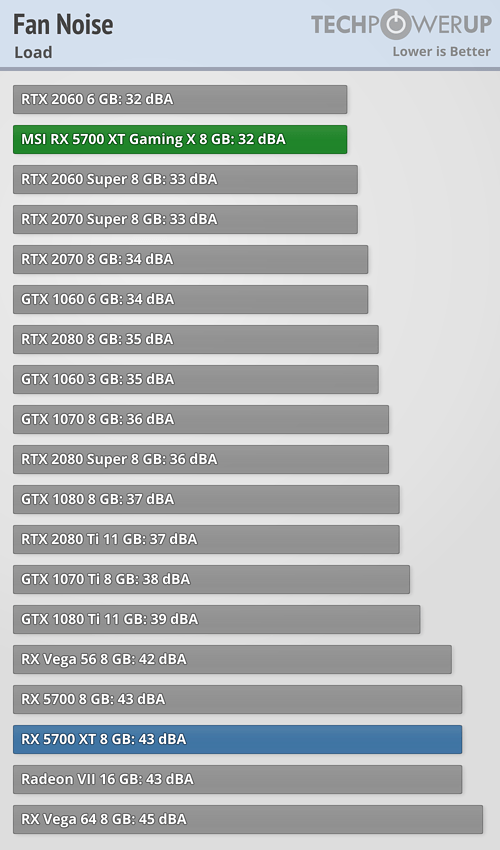 44
44
MSI Radeon RX 5700 XT Gaming X Review
Overclocking »Temperatures

| Temperature & Noise Comparison | ||||||
|---|---|---|---|---|---|---|
| Idle | Gaming | |||||
| GPU | Noise | GPU | Mem | VRM | Noise | |
| AMD RX 5700 | 45°C | 27 dBA | 79°C | 86°C | 67°C | 43 dBA |
| AMD RX 5700 XT | 48°C | 27 dBA | 92°C | 90°C | 77°C | 43 dBA |
| ASUS RX 5700 XT STRIX | 48°C | Fan Stop | 77°C | 82°C | 70°C | 36 dBA |
| ASUS RX 5700 XT STRIX (Quiet BIOS) | 54°C | Fan Stop | 82°C | 88°C | 76°C | 32 dBA |
| MSI RX 5700 XT Evoke | 51°C | Fan Stop | 69°C | 88°C | 78°C | 43 dBA |
| MSI RX 5700 XT Evoke (new BIOS) | 52°C | Fan Stop | 72°C | 90°C | 84°C | 39 dBA |
| MSI RX 5700 XT Gaming X | 52°C | Fan Stop | 70°C | 82°C | 65°C | 32 dBA |
| PowerColor RX 5700 XT Red Devil | 51°C | Fan Stop | 74°C | 78°C | 71°C | 31 dBA |
| PowerColor RX 5700 XT Red Devil (Quiet BIOS) | 51°C | Fan Stop | 79°C | 84°C | 74°C | 29 dBA |
| Sapphire RX 5700 XT Pulse | 49°C | Fan Stop | 75°C | 82°C | 68°C | 35 dBA |
| Sapphire RX 5700 XT Pulse (Quiet BIOS) | 51°C | Fan Stop | 74°C | 84°C | 70°C | 32 dBA |
| XFX RX 5700 XT Ultra | 50°C | Fan Stop | 76°C | 88°C | 83°C | 39 dBA |
| XFX RX 5700 XT Ultra (quiet BIOS) | 51°C | Fan Stop | 75°C | 88°C | 82°C | 37 dBA |
Fan Noise
It's good to see that unlike the AMD reference, MSI added the fan-stop-in-idle feature on their card, which provides the perfect noise-free experience during desktop work, Internet browsing, and light gaming.
Gaming noise levels are much improved over the AMD reference card and better than what we've seen on most other RX 5700 XT custom designs. What I would also highlight here is that MSI achieves the lowest temperature of all tested Navi cards while still being the second quietest.


May 5th, 2025 03:42 EDT
change timezone
Latest GPU Drivers
New Forum Posts
- Choosing an Internal HDD (61)
- Asus motherboard AM5 safe to buy in 2025? (15)
- Low budget psu for medium high loads (under 400 watt usage) (21)
- Post your Speedtest.net Speeds! (2360)
- It's happening again, melting 12v high pwr connectors (1053)
- Are the 8 GB cards worth it? (860)
- [AV1, AV2, AV3 codecs...] Have they given up on the AOMedia project? (15)
- RX 9000 series GPU Owners Club (639)
- I got a new motherboard about to start a DTS journey (2)
- Windows 11 General Discussion (6023)
Popular Reviews
- ASUS ROG Maximus Z890 Hero Review
- ASUS Radeon RX 9070 XT TUF OC Review
- Clair Obscur: Expedition 33 Performance Benchmark Review - 33 GPUs Tested
- Montech HS02 PRO Review
- NVIDIA GeForce RTX 5060 Ti 8 GB Review - So Many Compromises
- Seasonic Vertex GX 850 W Review
- Upcoming Hardware Launches 2025 (Updated Apr 2025)
- ASUS GeForce RTX 5090 Astral Liquid OC Review - The Most Expensive GPU I've Ever Tested
- Sapphire Radeon RX 9070 XT Nitro+ Review - Beating NVIDIA
- AMD Ryzen 7 9800X3D Review - The Best Gaming Processor
Controversial News Posts
- AMD Radeon RX 9060 XT to Roll Out 8 GB GDDR6 Edition, Despite Rumors (129)
- NVIDIA Sends MSRP Numbers to Partners: GeForce RTX 5060 Ti 8 GB at $379, RTX 5060 Ti 16 GB at $429 (128)
- NVIDIA Launches GeForce RTX 5060 Series, Beginning with RTX 5060 Ti This Week (115)
- Nintendo Confirms That Switch 2 Joy-Cons Will Not Utilize Hall Effect Stick Technology (105)
- NVIDIA PhysX and Flow Made Fully Open-Source (95)
- Sony Increases the PS5 Pricing in EMEA and ANZ by Around 25 Percent (84)
- Parts of NVIDIA GeForce RTX 50 Series GPU PCB Reach Over 100°C: Report (78)
- Intel "Bartlett Lake-S" Gaming CPU is Possible, More Hints Appear for a 12 P-Core SKU (77)
